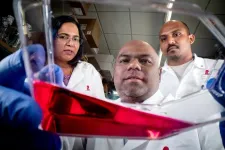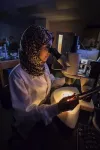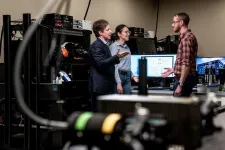(Press-News.org) CRISPR/Cas9 gene editing has made possible a multitude of biomedical experiments including studies that systematically turn off genes in cancer cells to look for ones that the cancer cells heavily depend on to survive and grow. These genes, or “cancer dependencies,” are often promising drug targets. But new research shows that many of these CRISPR screening experiments rely on components, called CRISPR/Cas9 guides, that do not perform equally well in cells from people of all ancestries, which can cause CRISPR screens to miss cancer dependencies.
These CRISPR guides are short sequences of RNA that steer the CRISPR Cas9 enzyme to a specific site in the genome to cut DNA and deactivate a targeted gene. The new findings, from scientists at the Broad Institute of MIT and Harvard, show about 2 percent of these guides miss their target. This means that Cas9 won’t make a cut and disable a specific gene, thereby obscuring a potential role of that gene in cancer growth. The team found that this happens disproportionately in cells from people of African ancestry, because CRISPR guides were designed using reference genomes from people who are largely of European ancestry and do not fully represent global genetic diversity.
“These inaccuracies exist in places we might not recognize and in ways that we wouldn't have predicted,” said Rameen Beroukhim, an associate member at the Broad and a co-senior author on the paper, which appeared recently in Nature Communications. “This work shows that it's really worthwhile to conduct a systematic assessment of all the tools and datasets that we're using so that we can fix these hidden biases before they become an issue.”
“CRISPR is used ubiquitously in preclinical research, but only a minority of researchers are thinking carefully about the specific germline and ancestries that relate to their model systems,” added Jesse Boehm, an associated scientist at the Broad and a co-senior author on the paper. “This is a warning call for the community that functional genomics is not immune to ancestry bias, and a source of opportunity to look more closely at this kind of data.”
In their study, the team analyzed data from the Broad’s Cancer Dependency Map (DepMap), the largest cancer dependency resource, which currently includes genome-wide screens in more than 1,000 cancer cell lines, about 90 percent of which are from people of European or East Asian descent.
Francisca Vazquez, director of the DepMap at the Broad, said that less than 1 percent of cell line-guide pairs in the DepMap are affected by the ancestry bias shown by this study, but that these biases are important to recognize and fix in future libraries. After these results were first posted as a preprint in 2022, the DepMap team removed from their library all guide RNAs that didn’t work, so that instead of falsely returning no dependencies for the affected genes, the database indicates that there is not sufficient data to draw conclusions.
A new kind of dependency search
Previously, the search for cancer dependencies focused on genetic changes that arise in some cells during a person’s life, called somatic mutations. But when postdoctoral researcher and study first author Sean Misek joined Boehm’s and Beroukhim’s labs in 2020, he wanted to know how germline genetic variants — which are inherited and in all cells throughout the body — influence how tumors respond to treatment.
Misek found many strong associations between ancestry and genetic dependencies, and that most of those associations came from artifacts related to germline variants. In particular, he saw these effects in CRISPR guides. The sequence of the guide RNAs didn’t sufficiently match the target genetic sequence because that target sequence varied depending on ancestry.
The scientists found that 89 percent of guides in genome-scale libraries have a mismatch in at least one cell line. They also found that mismatches occur to a greater degree in cells from people of African ancestry.
“These sorts of experimental biases are probably everywhere in preclinical research,” Misek said. “We hope that this paper is part of a larger conversation.”
Understanding the extent of this bias in a research project can be challenging for a scientist because it can take several days to download all the necessary data to do so. To address this, Boehm, Beroukhim, and the Pattern team at the Broad built Ancestry Garden, a website based on data from the Genome Aggregation Database (gnomAD) that can help researchers determine the effect of ancestry on a guide of their choosing.
“A lot of labs use CRISPR in some sense, and they should have a mechanism to check their reagents,” Misek said. “Our goal is to make it a little bit easier for people to mitigate this issue in their own hands.”
Library lessons
Boehm said that genetic variation due to ancestry affects research far beyond the search for cancer dependencies, and that the extent to which the team’s findings will impact individual studies will vary. Although the effect of this bias was relatively modest in the DepMap, it may be much larger in experiments that study only one or a small number of cell lines, Boehm said.
Going forward, the study team and DepMap researchers say that an important way to address this bias is to increase the genetic diversity in large-scale cell line libraries.
“We encourage the community to send us cell lines from under-represented populations if they have them,” Vazquez said. “This is a very important issue to address.”
***
About Broad Institute of MIT and Harvard
Broad Institute of MIT and Harvard was launched in 2004 to empower this generation of creative scientists to transform medicine. The Broad Institute seeks to describe the molecular components of life and their connections; discover the molecular basis of major human diseases; develop effective new approaches to diagnostics and therapeutics; and disseminate discoveries, tools, methods and data openly to the entire scientific community.
Founded by MIT, Harvard, Harvard-affiliated hospitals, and the visionary Los Angeles philanthropists Eli and Edythe L. Broad, the Broad Institute includes faculty, professional staff and students from throughout the MIT and Harvard biomedical research communities and beyond, with collaborations spanning over a hundred private and public institutions in more than 40 countries worldwide.
END
Some CRISPR screens may be missing cancer drug targets
Current CRISPR guides don’t work equally well in cells from people of all ancestries, which could lead to false negative results
2024-06-14
ELSE PRESS RELEASES FROM THIS DATE:
$18.5 million U19 grant will study B and T memory cells in transplanted lungs, uteruses and kidneys
2024-06-14
BIRMINGHAM, Ala. – Memory immune cells reside in many tissues, poised to react to a second infection or continuing antigen. Yet little is known about these tissue-resident memory cells — how they get there, how they evolve and how they compete in tissues.
A five-year, $18.5 million grant will allow University of Alabama at Birmingham researchers to investigate T and B tissue-resident memory cells, known as TRM and BRM cells, in three unique sites — transplanted lungs, transplanted kidneys and the transplanted ...
Improving soil health yields unexpected benefits for farmers
2024-06-14
In the U.S., as farmers wrestle with extreme heat and drought, heavy rainfall and flooding, and erosion—all factors of climate change which can take a toll on crops—there's been a lot of buzz over regenerative agriculture over the past few years, as big agriculture companies promise opportunities to make money from "carbon farming" while also improving soil health.
Regenerative farming strives to improve soil health through various methods, including reduced or no tillage, keeping the soil covered year-round through ...
NYCST announces inaugural awards for space technology projects
2024-06-14
The New York Consortium for Space Technology (NYCST) is led by Cornell University, which is funded by the U.S. Department of Defense’s Office of Local Defense Community Cooperation through the Defense Manufacturing Community Support Program.
Ithaca, NY— June 14, 2024 — The New York Consortium for Space Technology Innovation and Development (NYCST) today announced more than $300 thousand has been allocated to support 6 projects through the inaugural round of the consortium’s funding program. The projects were selected during NYCST’s inaugural ...
St. Jude scientists solve decades long mystery of NLRC5 sensor function in cell death
2024-06-14
(MEMPHIS, Tenn. – June 14, 2024) The innate immune system is responsible for protecting the human body from threats that could cause disease or infection. The system relies on innate immune sensors to detect and transmit signals about these threats. One of the key innate immune strategies to respond to threats is through cell death. New research from St. Jude Children’s Research Hospital discovered that NLRC5 plays a previously unknown role as an innate immune sensor, triggering cell death. The findings, published in Cell, show how NLRC5 drives PANoptosis, a prominent type of inflammatory cell death. This understanding has implications for the development of therapeutics ...
Gonadal function in male mice disrupted by prenatal risk factors
2024-06-14
Researchers have consistently shown that prenatal exposure to Di (2-ethyhexyl) phthalate harms the reproductive system in male mice and causes fertility defects. In a new study, scientists from the University of Illinois Urbana-Champaign have shown that the combination of DEHP and a high-fat diet in pregnant mice can cause more damage to pups than each factor alone.
Male reproductive disorders are a growing issue due to the global decrease in sperm count and quality. Concerningly, chemicals like DEHP, which can be found in food storage containers, pharmaceuticals, and building materials, have been ...
Endangered sea cucumbers for sale in NYC food markets
2024-06-14
ITHACA, N.Y. - After surveying food market retailers in three New York City Chinatown districts, Cornell University researchers have found genetic evidence that some endangered species of sea cucumbers – considered a pricey but nutritious dried delicacy – are being sold to consumers.
The researchers collected 103 samples of dried sea cucumbers from retail food shops. By using mitochondrial DNA testing, they successfully identified 74 examples of sea cucumbers. Eight were classified as brown sea cucumbers– which are threatened and found on the International Union for the Conservation of Nature (IUCN) Red List due to overharvesting.
“We ...
Infectious H5N1 influenza virus in raw milk rapidly declines with heat treatment
2024-06-14
WHAT:
The amount of infectious H5N1 influenza viruses in raw milk rapidly declined with heat treatment in laboratory research conducted by scientists at the National Institute of Allergy and Infectious Diseases (NIAID), part of the National Institutes of Health. However, small, detectable amounts of infectious virus remained in raw milk samples with high virus levels when treated at 72 degrees Celsius (161.6 degrees Fahrenheit) for 15 seconds—one of the standard pasteurization methods used by the dairy industry. The authors of the study stress, ...
Erk5 and its potential applications in cancer treatment
2024-06-14
“Elucidating the function of Erk5 in cancer [...] will contribute to a better understanding of cancer pathogenesis and the development of novel therapeutic strategies.”
BUFFALO, NY- June 14, 2024 – A new editorial paper was published in Oncoscience (Volume 11) on May 20, 2024, entitled, “Role of Erk5 expressed in bone marrow mesenchymal stem cells on bone homeostasis and its potential applications in cancer treatment.”
In their new editorial, researchers Tetsuhiro Horie and Eiichi Hinoi from Kanazawa ...
Novel insights into fluorescent ‘dark states’ illuminate ways forward for improved imaging
2024-06-14
(MEMPHIS, Tenn. – June 14, 2024) Scientists at St. Jude Children’s Research Hospital today announced a way to improve molecular scale distance measurements using single-molecule fluorescence resonance energy transfer (smFRET). smFRET quantifies the excitation and emission properties of chemicals called fluorophores.
When an excited electron in the fluorophore relaxes, it emits light after a delay, causing the molecule to glow (fluoresce). However, fluorophores don’t always fluoresce after excitation. Instead, through quantum mechanical ...
UT Health San Antonio School of Dentistry to launch new Center for Regenerative Sciences
2024-06-14
SAN ANTONIO, June 14, 2024 – The University of Texas Health Science Center at San Antonio School of Dentistry is preparing to launch its Center for Regenerative Sciences, a new research initiative that aims to position the university at the forefront of regenerative dentistry and medicine.
“The center will provide new avenues for interdisciplinary collaborations to accelerate the translation of preclinical discoveries into therapeutic benefit for patients suffering from dental, oral and craniofacial diseases,” said Yong-Hee Chun, DDS, PhD, MS, associate professor of ...
LAST 30 PRESS RELEASES:
Interaction of climate change and human activity and its impact on plant diversity in Qinghai-Tibet plateau
From addressing uncertainty to national strategy: an interpretation of Professor Lim Siong Guan’s views
Clinical trials on AI language model use in digestive healthcare
Scientists improve robotic visual–inertial trajectory localization accuracy using cross-modal interaction and selection techniques
Correlation between cancer cachexia and immune-related adverse events in HCC
Human adipose tissue: a new source for functional organoids
Metro lines double as freight highways during off-peak hours, Beijing study shows
Biomedical functions and applications of nanomaterials in tumor diagnosis and treatment: perspectives from ophthalmic oncology
3D imaging unveils how passivation improves perovskite solar cell performance
Enriching framework Al sites in 8-membered rings of Cu-SSZ-39 zeolite to enhance low-temperature ammonia selective catalytic reduction performance
AI-powered RNA drug development: a new frontier in therapeutics
Decoupling the HOR enhancement on PtRu: Dynamically matching interfacial water to reaction coordinates
Sulfur isn’t poisonous when it synergistically acts with phosphine in olefins hydroformylation
URI researchers uncover molecular mechanisms behind speciation in corals
Chitin based carbon aerogel offers a cleaner way to store thermal energy
Tracing hidden sources of nitrate pollution in rapidly changing rural urban landscapes
Viruses on plastic pollution may quietly accelerate the spread of antibiotic resistance
Three UH Rainbow Babies & Children’s faculty elected to prestigious American Pediatric Society
Tunnel resilience models unveiled to aid post-earthquake recovery
Satellite communication systems: the future of 5G/6G connectivity
Space computing power networks: a new frontier for satellite technologies
Experiments advance potential of protein that makes hydrogen sulfide as a therapeutic target for Alzheimer’s disease
Examining private equity’s role in fertility care
Current Molecular Pharmacology achieves a landmark: real-time CiteScore advances to 7.2
Skeletal muscle epigenetic clocks developed using postmortem tissue from an Asian population
Estimating unemployment rates with social media data
Climate policies can backfire by eroding “green” values, study finds
Too much screen time too soon? A*STAR study links infant screen exposure to brain changes and teen anxiety
Global psychiatry mourns Professor Dan Stein, visionary who transformed mental health science across Africa and beyond
KIST develops eco-friendly palladium recovery technology to safeguard resource security
[Press-News.org] Some CRISPR screens may be missing cancer drug targetsCurrent CRISPR guides don’t work equally well in cells from people of all ancestries, which could lead to false negative results





